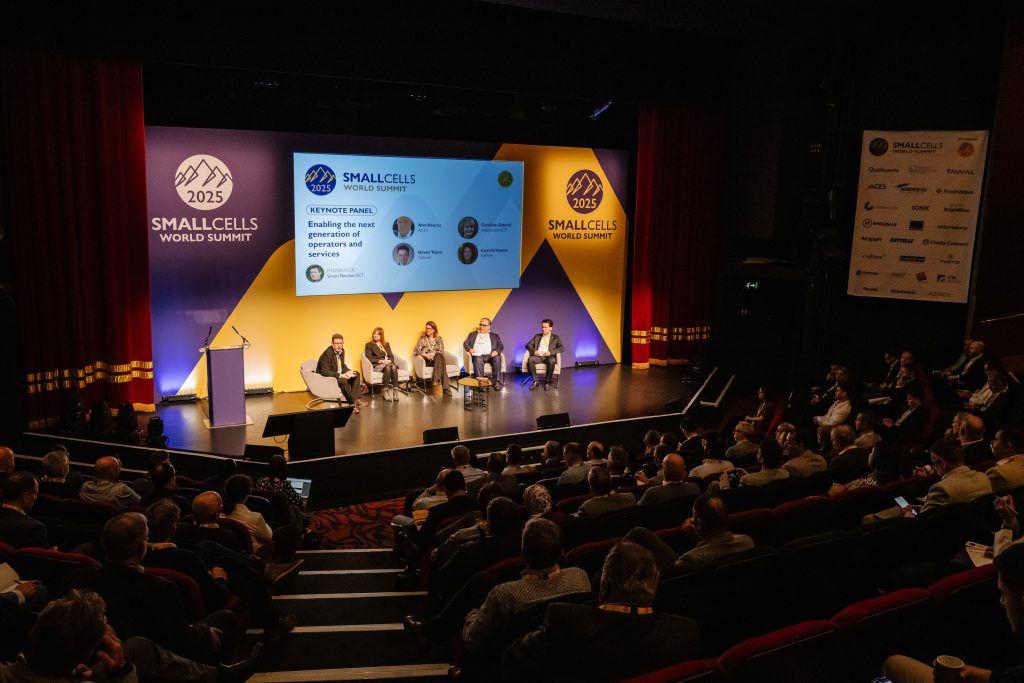If ever there was a vehicle to distil all the key themes in the small cells industry, the barriers to deployment, the growing opportunities, and more in just two days, then SCWS was it. From the highly commercial to the deeply technical and the regulatory and policy issues – we covered it all. Taking a step back and thinking about all the content and discussions during those two busy days, we had a sense that finally as an industry we seem to be moving in the right direction, and even more importantly we are moving together.
The presentations and workshop on the UK JOTS specifications (Joint Operator Technical Specifications for neutral host in-building and now for outside too) proved just that – collaboration can drive real positive change. This is an area we want to build on globally in SCF, to blueprint this work and extend it to other regions that could benefit from similar models. It was fitting to host the very first live 5G video call using JOTS on Day 1, and to recognise David Morris (retiring Chair of the Mobile UK JOTS Forum) during the SCF Mobile Network Awards.
The first session of the day felt strongly aligned to SCF’s mission to drive innovation, collaboration and best-practice in multi-purpose networks and Caroline Gabriel’s presentation of the market forecast – which as ever was played out to a packed auditorium – gave optimism with a healthy dose of pragmatism.
She set the scene by pointing out that economic uncertainty and the hold-ups caused by Covid have contributed to lower than hoped-for mobile operator expenditure. However, she also suggested that small cell deployment is moving in the right direction and will be accelerating by 2027, spurred on by interest from enterprise and private networks, among a number of areas that want, but don’t always have, excellent coverage and capacity.
Indeed, VM02, WIG and other presenters showed that stadiums, venues, airports, shopping centres, hotels, hospitals and high-capacity urban areas could benefit from small cells or DAS. Some are benefiting already. Neutral hosts are emerging as the economic option for deploying small cells, for example Freshwave has had success with ‘pay as you occupy’ and ‘landlord pays’ models. Could these be ways forward?
The neutral host model is still finding its feet – but as SCWS showed in abundance this year, it’s becoming increasingly hard to deny its benefits. Examples from the DAS world, in Dortmund’s football stadium and the US Superbowl, showed how neutral host is working.
However, a more prosaic issue is affecting small cell-based opportunities for local government: who do we speak to? Questions of regulation, coverage analysis, infill needs, asset ownership and use of street furniture are being complicated by councils that don’t understand and MNOs that don’t explain. And yet some UK councils – like Barnet, Oxfordshire and Glasgow – are seizing the telecoms opportunity by appointing their own digital champions – who appeared at SCWS – and showing how local authorities can benefit in terms of better services, better coverage and more cost savings. It was notable how many local authorities attended SCWS this year – proving there is interest in small cells and their benefits for public coverage and SCF will be extending its work in this area for 2025-26.
Open RAN, meanwhile, is a work in progress, especially for small cells. There are not yet enough vendors or CapEx savings for MNOs to embrace Open RAN unreservedly. And yet standards work from the O-RAN ALLIANCE (appearing at SCWS via video link from Japan on Day 2), SCF, 3GPP and elsewhere are enabling the improvements that could lower TCO and save space and power – something that can already be demonstrated by DAS vendor SOLiD via its stadium coverage in Dortmund, presented during the stadiums session.
Indeed, standardisation and specification are moving on apace. The example of the work of JOTS, as previously mentioned a key one. The next step, however, as more than one speaker recognised, is bridging the gap between the standards world and real networks with clear, comprehensible use case demos, blueprints, and case studies. Some pioneers – like Cornerstone with its work on bridging outdoor connectivity gaps alongside Signify and IONX Networks – are already doing just that.
Among positive news, access to spectrum is less of a problem than it once was. However, lack of devices to use that spectrum could be an issue. Nevertheless, as Microamp showed, security, retail and broadcast opportunities can still drive usage opportunities – notably of mmWave – in the absence of handsets.
And that’s far from all. SCWS was as ever a wide-ranging and fascinating event, examining or touching on network sharing, neutral host, standardization, regulation, sustainability, business models, Open RAN, planning tools, enterprise needs, coverage, automation, AI, IIoT and much more. Some of these issues will be discussed in more detail in follow-up blogs.
So are we there yet? Not yet, no. But, after a tricky few years, the industry is most certainly moving in the right direction and if the positive energy in the SCWS exhibition hall and collaboration over coffee was anything to go by we have an exciting year ahead – we look forward to finding out more in 2026!
You can access the presentations and resources from SCWS 2025 here.
